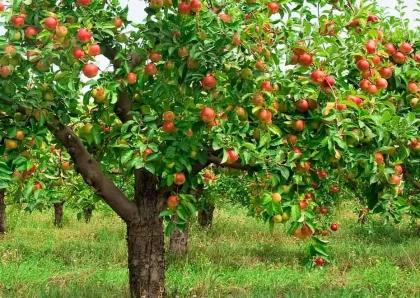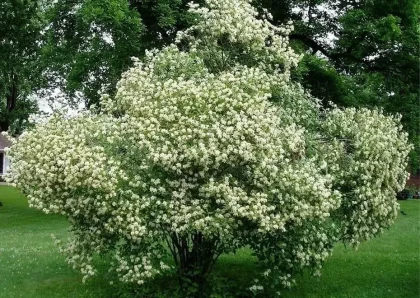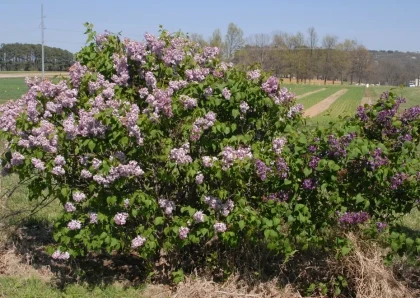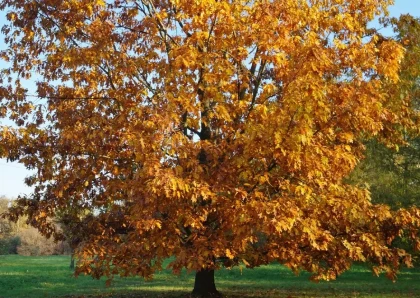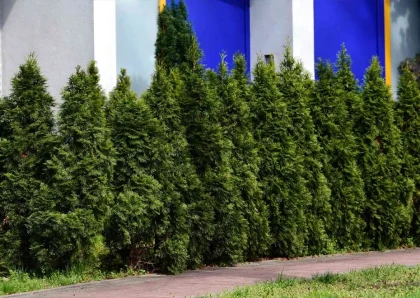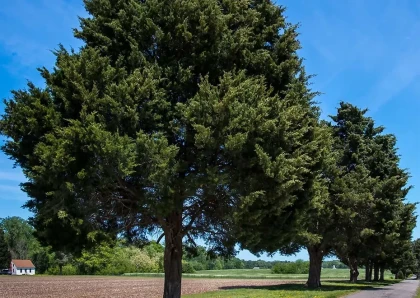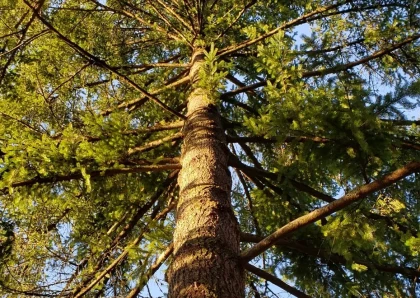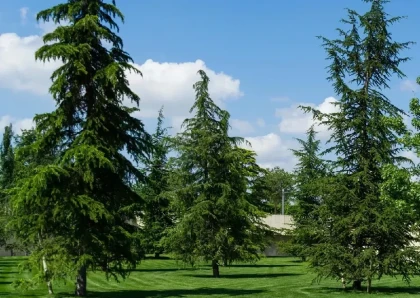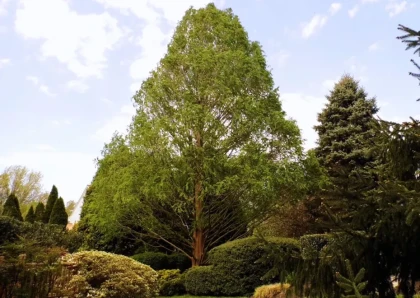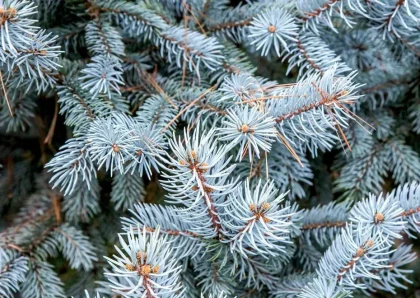
Chinese Pistache Tree
Overview
Description
Overview
The Chinese Pistache Tree, also known as Pistacia chinensis, is a deciduous tree that is native to China and Taiwan. It belongs to the genus Pistacia, which also includes other well-known species like the pistachio tree (Pistacia vera).
Key Characteristics
- Size: The tree can reach a height of 30 to 60 feet (9 to 18 meters) and has a spread of about 25 to 35 feet (7.5 to 10.5 meters) when fully mature.
- Foliage: The leaves are compound, typically consisting of 10 to 16 leaflets. During the growing season, the leaves have a glossy green color, and in the fall, they turn into brilliant shades of orange, red, and even purple, making it a desirable choice for autumn landscapes.
- Flowers: Inconspicuous small greenish flowers appear in spring, but they are not particularly showy.
- Fruit: The tree produces small, reddish-brown drupes (fruits) that are not commonly eaten by humans but are attractive to birds.
- Drought Tolerance: The Chinese Pistache is known for its ability to withstand dry conditions and is considered a drought-tolerant tree once established.
- Landscape Use: It is commonly planted as a shade tree in urban and suburban landscapes, parks, and along streets due to its attractive appearance and low maintenance requirements.
- Invasive Potential: Unlike its relative, the invasive tree called Tree of Heaven (Ailanthus altissima), the Chinese Pistache is not considered invasive in most regions where it is grown.
Types of Chinese Pistache Tree
1. 'Keith Davey' Chinese Pistache (Pistacia chinensis 'Keith Davey')
This cultivar is known for its exceptional red fall foliage. The leaves turn vibrant shades of red, orange, and burgundy, making it a highly sought-after tree for autumn landscapes.
2. 'Red Push' Chinese Pistache (Pistacia chinensis 'Red Push')
This variety is valued for its intense red fall color. The leaves of 'Red Push' turn bright red earlier in the season compared to other cultivars.
3. 'Golden Jubilee' Chinese Pistache (Pistacia chinensis 'Golden Jubilee')
This cultivar is unique for its golden-yellow foliage during the autumn months. It provides a striking contrast to other trees and plants in the landscape.
4. 'Chinese Pistache Lacebark' (Pistacia chinensis 'Lacebark')
This variety is appreciated for its exfoliating bark, which reveals a patchwork of colors, including beige, gray, orange, and brown. The textured bark adds winter interest to the tree's appeal.
5. 'Gawler' Chinese Pistache (Pistacia chinensis 'Gawler')
This cultivar is notable for its attractive, compact size and dense growth habit. It is well-suited for smaller landscapes or as a street tree.
6. 'Red Masterpiece' Chinese Pistache (Pistacia chinensis 'Red Masterpiece')
This cultivar is prized for its deep red fall foliage and its vigorous growth habit.
7. 'Palo Alto' Chinese Pistache (Pistacia chinensis 'Palo Alto')
This variety is known for its relatively early display of fall colors, with leaves transitioning to shades of orange and red.
Wood Products from Chinese Pistache Tree
1. Woodcrafts: The wood of Chinese Pistache can be used for crafting small wooden items such as decorative boxes, picture frames, and intricate carvings. Its fine grain and attractive color can lend a unique touch to these craft projects.
2. Turned Objects: Chinese Pistache wood can be turned on a lathe to create bowls, vases, pens, and other turned objects. Its beautiful grain patterns and distinct coloring can make these turned items visually appealing.
3. Walking Sticks and Canes: The sturdy and relatively lightweight nature of Chinese Pistache wood makes it suitable for crafting walking sticks and canes. Its attractive appearance can add a touch of elegance to these functional items.
4. Furniture Inlays: Chinese Pistache wood's unique color and grain patterns can be utilized as inlays in furniture making. It can be used as decorative accents on tabletops, cabinet doors, or other furniture pieces.
5. Handles and Grips: The wood can be fashioned into handles and grips for various tools and utensils, such as kitchen knives, gardening tools, and handcrafted utensils.
6. Woodworking Projects: Chinese Pistache wood can be used as a material in various woodworking projects like small sculptures, jewelry boxes, cutting boards, and coasters.
7. Art and Craft Projects: The wood's attractive appearance makes it suitable for artistic projects, such as woodburning, painting, or engraving.
Benefits of Wood Products from Chinese Pistache Tree
1. Attractive Appearance: Chinese Pistache wood exhibits a unique and appealing combination of grain patterns and colors. It often features a fine grain with occasional swirls or interesting figuring, making it visually appealing for a range of woodworking projects.
2. Unique Coloration: The wood of the Chinese Pistache Tree can display a variety of colors, including light to dark browns, reds, and occasional purples. This natural variation in color adds character and uniqueness to wood products.
3. Workability: Chinese Pistache wood is relatively easy to work with due to its moderate density and straight grain. It responds well to sawing, carving, turning, and other woodworking techniques.
4. Durability: While not as dense and durable as some hardwoods, Chinese Pistache wood can still offer satisfactory durability for various indoor applications, especially when appropriately finished and cared for.
5. Environmental Considerations: Chinese Pistache is not typically grown for timber purposes, but using wood from trees already being removed for landscaping or other reasons can be a sustainable and environmentally friendly option.
6. Smaller-Scale Projects: Chinese Pistache wood is well-suited for smaller woodworking projects, such as decorative items, craft projects, turned objects, and art pieces.
7. Unique Woodworking Projects: The distinct characteristics of Chinese Pistache wood, such as its color and grain patterns, can make it particularly suitable for artistic and specialty woodworking projects where a unique and eye-catching appearance is desired.
8. Local Sourcing: If you have access to Chinese Pistache trees locally, using their wood for crafts or projects can support local sourcing and reduce transportation-related environmental impacts.
Tips for Planting and Maintaining Chinese Pistache Tree
Planting:
- Choose the right location: Select a location with full sun exposure, as Chinese Pistache trees thrive in sunlight. Ensure the planting area has well-draining soil to prevent waterlogged roots.
- Soil preparation: Before planting, amend the soil with organic matter to improve its fertility and drainage. This will provide a good foundation for the tree's growth.
- Planting depth: Dig a hole that is slightly shallower than the root ball of the tree but wider than the root ball. The top of the root ball should be level with the ground surface.
- Watering: After planting, water the tree thoroughly to settle the soil and encourage root establishment. Provide regular watering during the tree's first growing season.
Maintenance:
- Watering: Chinese Pistache trees are drought-tolerant once established, but regular watering is essential during the first couple of years after planting. Provide deep, infrequent waterings to encourage deep root growth.
- Mulching: Apply a layer of organic mulch around the base of the tree to conserve moisture, regulate soil temperature, and suppress weed growth. Keep the mulch away from the trunk to avoid moisture-related issues.
- Pruning: Prune the tree during the dormant season to shape it and remove any dead or damaged branches. Chinese Pistache trees have a natural, attractive shape, so minimal pruning is typically required.
- Fertilizing: Chinese Pistache trees generally do not require heavy fertilization. A balanced, slow-release fertilizer applied in the spring can be beneficial, but avoid excessive nitrogen, as it may promote excessive foliage growth at the expense of fall coloration.
- Pest and disease control: Chinese Pistache trees are relatively pest and disease-resistant, but occasional issues may arise. Monitor the tree regularly and take appropriate action if any problems are detected.
- Protecting from extreme conditions: During harsh winter conditions or hot summers, young Chinese Pistache trees may benefit from additional protection. Using tree wraps or shading the trunk during hot weather can be helpful.
Cons of Planting Chinese Pistache Tree
1. Invasive Potential:
In some regions, Chinese Pistache has shown invasive tendencies, particularly in parts of the United States. It can spread rapidly through the production of numerous seeds, potentially outcompeting native vegetation and disrupting local ecosystems.
2. Seedlings Everywhere:
The tree produces a significant number of seeds, and these seedlings can become a nuisance if they start growing in unwanted areas, such as lawns or gardens. Regularly removing or managing seedlings might be necessary.
3. Aggressive Roots:
Like many trees, Chinese Pistache has roots that can be invasive and potentially cause damage to sidewalks, driveways, and other nearby structures. Planting it too close to buildings or hardscape features should be avoided.
4. Messy Fruits:
While the fruits are not generally consumed by humans, they can be messy when they fall from the tree, potentially staining walkways or creating a litter issue.
5. Susceptibility to Some Pests and Diseases:
While Chinese Pistache trees are generally considered relatively pest and disease resistant, they can still be susceptible to certain issues, such as aphids, leaf spot diseases, and cankers.
6. Not Suitable for Cold Climates:
Chinese Pistache trees are more suited to warmer climates and may not fare well in areas with extremely cold winters or frequent frost.
7. Limited Timber Use:
The wood of Chinese Pistache is not commonly used for commercial timber production due to its small size and the availability of more suitable timber species.
8. Allergenic Potential:
Some people might be sensitive to the pollen produced by Chinese Pistache trees, leading to allergic reactions during the flowering season.
Conclusion
In conclusion, the Chinese Pistache Tree (Pistacia chinensis) is a beautiful and versatile tree that offers several attractive features. Its vibrant fall foliage, resistance to drought, and relatively low maintenance requirements make it a popular choice for landscaping and urban environments. Additionally, the tree's small to medium size allows it to fit well in various settings, including smaller gardens and streetscapes.
However, it is essential to be aware of some potential drawbacks when considering planting a Chinese Pistache Tree. These include its invasive potential in certain regions, the abundance of seedlings it can produce, and the aggressive nature of its roots, which may cause damage to nearby structures. Additionally, the tree's messy fruits and its susceptibility to some pests and diseases are factors to consider.
Despite these cons, proper care and management can help mitigate many of the potential issues associated with Chinese Pistache trees. It is crucial to choose an appropriate planting location, provide adequate water during the establishment phase, and take preventive measures to control seedlings and invasive root growth.
Overall, the Chinese Pistache Tree can be a valuable addition to landscapes, offering striking foliage colors, providing shade and beauty, and contributing to the overall environmental health. When planted and maintained thoughtfully, it can be an asset to gardens, parks, and urban green spaces, enriching the environment with its unique characteristics and adding visual appeal to the surroundings.
Frequently Asked Questions (FAQs)
1. What is the scientific name of the Chinese Pistache Tree?
The scientific name of the Chinese Pistache Tree is Pistacia chinensis.
2. What are the key characteristics of the Chinese Pistache Tree?
The Chinese Pistache Tree is a deciduous tree known for its vibrant fall foliage colors, which range from shades of orange, red, and purple. It has compound leaves with pointed leaflets and produces small, red fruits.
3. How tall and wide does the Chinese Pistache Tree typically grow?
Chinese Pistache Trees can reach a height of about 25 to 35 feet (7.6 to 10.7 meters) and have a spread of 25 to 35 feet (7.6 to 10.7 meters) when mature.
4. Does the Chinese Pistache Tree require full sun exposure?
Yes, the Chinese Pistache Tree thrives in full sun exposure and prefers well-draining soil.
5. Is the Chinese Pistache Tree drought-tolerant?
Yes, once established, Chinese Pistache Trees are relatively drought-tolerant and can withstand periods of reduced water availability.
6. Can Chinese Pistache Trees be planted in cold climates?
Chinese Pistache Trees are more suited to warmer climates and may not fare well in areas with extremely cold winters or frequent frost.
7. Are Chinese Pistache Trees invasive?
In some regions, Chinese Pistache Trees have shown invasive tendencies, particularly in parts of the United States, where they can spread rapidly through seed production.
8. Do Chinese Pistache Trees attract wildlife?
Yes, the red fruits produced by Chinese Pistache Trees can attract birds and other wildlife.
9. How should Chinese Pistache Trees be pruned?
Chinese Pistache Trees generally require minimal pruning. Prune during the dormant season to shape the tree and remove any dead or damaged branches.
10. Are Chinese Pistache Trees susceptible to pests and diseases?
While Chinese Pistache Trees are generally considered relatively pest and disease-resistant, they can still be susceptible to certain issues, such as aphids, leaf spot diseases, and cankers.
No listings available
Related Products
Golden Jubilee Peach Tree
Prunus persica 'Golden Jubilee' is a specific cultivar of peach tree. It is a deciduous fruit tree belonging to the Rosaceae family. 'Golden Jubilee'...
Gray Dogwood
Cornus racemosa, commonly known as the gray dogwood or northern swamp dogwood, is a deciduous shrub native to eastern North America. It belongs to...
Common Fragrant Lilac
Syringa vulgaris, commonly known as the Common Lilac or French Lilac, is a deciduous shrub belonging to the genus Syringa in the olive family...
European Beech Tree
The European Beech (Fagus sylvatica) is a deciduous tree species native to much of Europe, including parts of western Asia. It is one of...
Emerald Arborvitae Tree
The Emerald Arborvitae (Thuja occidentalis 'Smaragd') is a popular evergreen tree or shrub in landscaping and gardening. It belongs to the cypress family (Cupressaceae)...
Eastern Red Cedar Tree
The Eastern Red Cedar, scientifically known as Juniperus virginiana, is a species of evergreen tree native to eastern North America. It belongs to the...
Douglas Fir Tree
The Douglas Fir (Pseudotsuga menziesii) is an evergreen coniferous tree that belongs to the Pinaceae family. It is one of the most common and...
Deodar Cedar Tree
The name "Deodar" is derived from the Sanskrit words "deva" (meaning "god") and "daru" (meaning "wood" or "tree"), hence it is often referred to...
Dawn Redwood Tree
The Dawn Redwood tree, scientifically known as Metasequoia glyptostroboides, is a deciduous coniferous tree that belongs to the family Cupressaceae. It is a unique...
Colorado Blue Spruce Tree
The Colorado Blue Spruce, scientifically known as Picea pungens, is a species of coniferous tree belonging to the Pinaceae family. It is native to...




